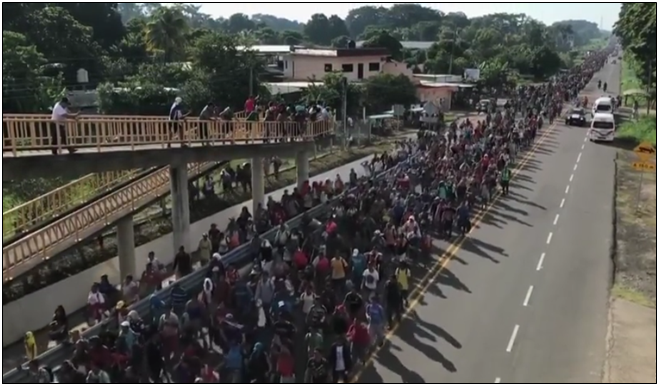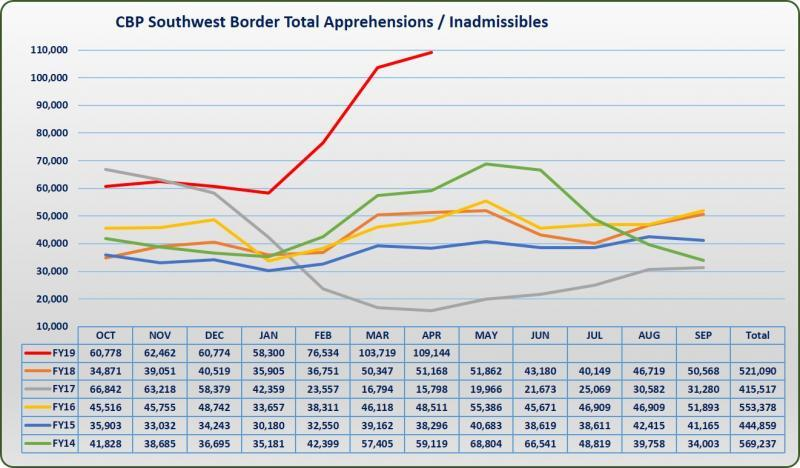Apprehensions on the southern border hit 109,144 in April, the highest in a decade, according to data compiled by the U.S. Customs and Border Patrol.
It’s already larger than last year. Seven months into fiscal year 2019, with 531,711 apprehensions it has already topped the amount of apprehensions in all of fiscal year 2018, which was 521,090. This year could top 1 million if it continues accelerating.
It also beats fiscal years 2017 and 2015, and after next month could be larger than fiscal years 2016 and 2014.
According to a White House fact sheet, of the 109,144, “Over 61,000 of these illegal aliens arrived at the border as a part of family units, while over 9,000 were unaccompanied alien children,” accounting for almost two-thirds the total.
And thanks to the 1997 Flores consent decree, the federal government is required to release illegal aliens with minors after 20 days.
Plus, the 2008 Trafficking Victims Protection Reauthorization Act makes it illegal to send unaccompanied minors from Central America back home to their countries.
Making matters worse, Immigration and Customs Enforcement has just 52,000 beds to detain those apprehended at the border, meaning a good deal of those coming will simply have to be let go.
And Congress made sure of that. Besides doing nothing to remove the incentives under Flores and the 2008 act, last year, the authorization in the spending bill allowed for an average daily of 40,520 beds, but President Donald Trump increased that to 49,000 by moving things around in the budget. This year, the new baseline is 45,274 beds that can be ratcheted up to 52,000. Not nearly enough to deal with the current flood of migration.
That is why President Trump has another $4.5 billion supplemental request into Congress for additional facilities and resources needed to effectively manage the humanitarian crisis — and that’s what it is, a crisis — at the border. $3.3 billion of that will go to humanitarian assistance, including enough beds for everyone who is being apprehended.
Of course, none of this would be necessary if the border were secured. Congress only included $1.6 billion from 2018 for replacing existing fencing with new steel barriers and $1.375 billion in 2019 for more steel barriers. President Trump had to resort to declaring a national emergency to unlock another $6.7 billion military construction funds, which Congressional Democrats are now challenging in court.
In addition, Congressional Democrats want to attach a policy rider to legislation that would defund the military construction route for building the wall.
House Appropriations Committee Chairwoman Nita Lowey (D-N.Y.) said the bill will ensure “we protect these vital military construction resources from misappropriation for the President’s wasteful border wall.”
To its credit, the House Freedom Caucus has announced it will oppose the measure. House Republican leaders need to follow suit, and work with Senate leaders to ensure it stays out of any final legislation, which President Trump will most assuredly veto.
Assuming that funding moves forward, Lt. Gen. Todd T. Semonite, Chief of Engineers and Commanding General of the U.S. Army Corps of Engineers, reporting from Calexico, Calif. told President Trump about 450 miles of wall will be built in 2019 and 2020: “Around Dec. 2020, the total amount of money we will have put in the ground in the last couple of years will be about 450 miles. That’s probably about $8 billion, in total about 33 projects.”
That is good, and can help create a deterrent for migrants to not make the journey. But besides the unfinished wall, one of the major attractions are the nation’s broken asylum laws.
The Trump administration is already addressing that in part with a new order from Attorney General William Barr to immigration judges that will block those making asylum claims from being released on bond while their proceedings are ongoing. The order states, “An alien who is transferred from expedited removal proceedings to full removal proceedings after establishing a credible fear of persecution or torture is ineligible for release on bond. Such an alien must be detained until his removal proceedings conclude, unless he is granted parole.” This will certainly rein in those failing to make court appearances.
But not everyone is making asylum claims, and are simply relying on the system being overwhelmed, as it is now, plus arriving with children as a ready means to get into the country. To end catch-and-release, Congress needs to step up and provide the resources that are needed, overturn the Flores decision and reform the 2008 law to allow unaccompanied minors who are not victims of trafficking to be deported. Doing so would mitigate the need in the future for things like the $4.5 billion supplemental for more beds. And finish the wall. As it is, Congress is creating this crisis by refusing to remove these loopholes. It wants catch-and-release.
Correction: A previous version of this article wrongly attributed a quote to House Appropriations Subcommittee on Military Construction, Veterans Affairs, and Related Agencies Chairwoman Debbie Wasserman Schultz (D-Fla.). The statement actually came from House Appropriations Committee Chairwoman Nita Lowey (D-N.Y.) and the article has been corrected to reflect this.
Robert Romano is the Vice President of Public Policy at Americans for Limited Government.








